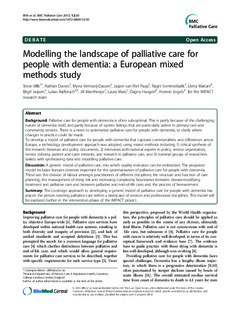| dc.contributor.author | Iliffe, Steve | |
| dc.contributor.author | Davies, Nathan | |
| dc.contributor.author | Vernooij-Dassen, Myrra | |
| dc.contributor.author | van Riet Paap, Jasper | |
| dc.contributor.author | Sommerbakk, Ragni | |
| dc.contributor.author | Mariani, Elena | |
| dc.contributor.author | Jaspers, Birgit | |
| dc.contributor.author | Radbruch, Lukas | |
| dc.contributor.author | Manthorpe, Jill | |
| dc.contributor.author | Maio, Laura | |
| dc.contributor.author | Haugen, Dagny Faksvåg | |
| dc.contributor.author | Engels, Yvonne | |
| dc.date.accessioned | 2019-10-28T07:58:22Z | |
| dc.date.available | 2019-10-28T07:58:22Z | |
| dc.date.created | 2013-12-13T09:54:05Z | |
| dc.date.issued | 2013 | |
| dc.identifier.issn | 1472-684X | |
| dc.identifier.uri | http://hdl.handle.net/11250/2624759 | |
| dc.description.abstract | Background
Palliative care for people with dementia is often sub-optimal. This is partly because of the challenging nature of dementia itself, and partly because of system failings that are particularly salient in primary care and community services. There is a need to systematize palliative care for people with dementia, to clarify where changes in practice could be made.
To develop a model of palliative care for people with dementia that captures commonalities and differences across Europe, a technology development approach was adopted, using mixed methods including 1) critical synthesis of the research literature and policy documents, 2) interviews with national experts in policy, service organisation, service delivery, patient and carer interests, and research in palliative care, and 3) nominal groups of researchers tasked with synthesising data and modelling palliative care.
Discussion
A generic model of palliative care, into which quality indicators can be embedded. The proposed model includes features deemed important for the systematisation of palliative care for people with dementia. These are: the division of labour amongst practitioners of different disciplines; the structure and function of care planning; the management of rising risk and increasing complexity; boundaries between disease-modifying treatment and palliative care and between palliative and end-of-life care; and the process of bereavement.
Summary
The co-design approach to developing a generic model of palliative care for people with dementia has placed the person needing palliative care within a landscape of services and professional disciplines. This model will be explored further in the intervention phase of the IMPACT project. | nb_NO |
| dc.language.iso | eng | nb_NO |
| dc.publisher | BMC (part of Springer Nature) | nb_NO |
| dc.rights | Navngivelse 4.0 Internasjonal | * |
| dc.rights.uri | http://creativecommons.org/licenses/by/4.0/deed.no | * |
| dc.title | Modelling the landscape of palliative care for people with dementia: a European mixed methods study | nb_NO |
| dc.type | Journal article | nb_NO |
| dc.type | Peer reviewed | nb_NO |
| dc.description.version | publishedVersion | nb_NO |
| dc.source.volume | 12 | nb_NO |
| dc.source.journal | BMC Palliative Care | nb_NO |
| dc.identifier.doi | 10.1186/1472-684X-12-30 | |
| dc.identifier.cristin | 1076341 | |
| dc.description.localcode | © 2013 Iliffe et al.; licensee BioMed Central Ltd. This is an Open Access article distributed under the terms of the Creative Commons Attribution License (http://creativecommons.org/licenses/by/2.0), which permits unrestricted use, distribution, and reproduction in any medium, provided the original work is properly cited. | nb_NO |
| cristin.unitcode | 194,65,15,0 | |
| cristin.unitname | Institutt for klinisk og molekylær medisin | |
| cristin.ispublished | true | |
| cristin.fulltext | original | |
| cristin.qualitycode | 1 | |

